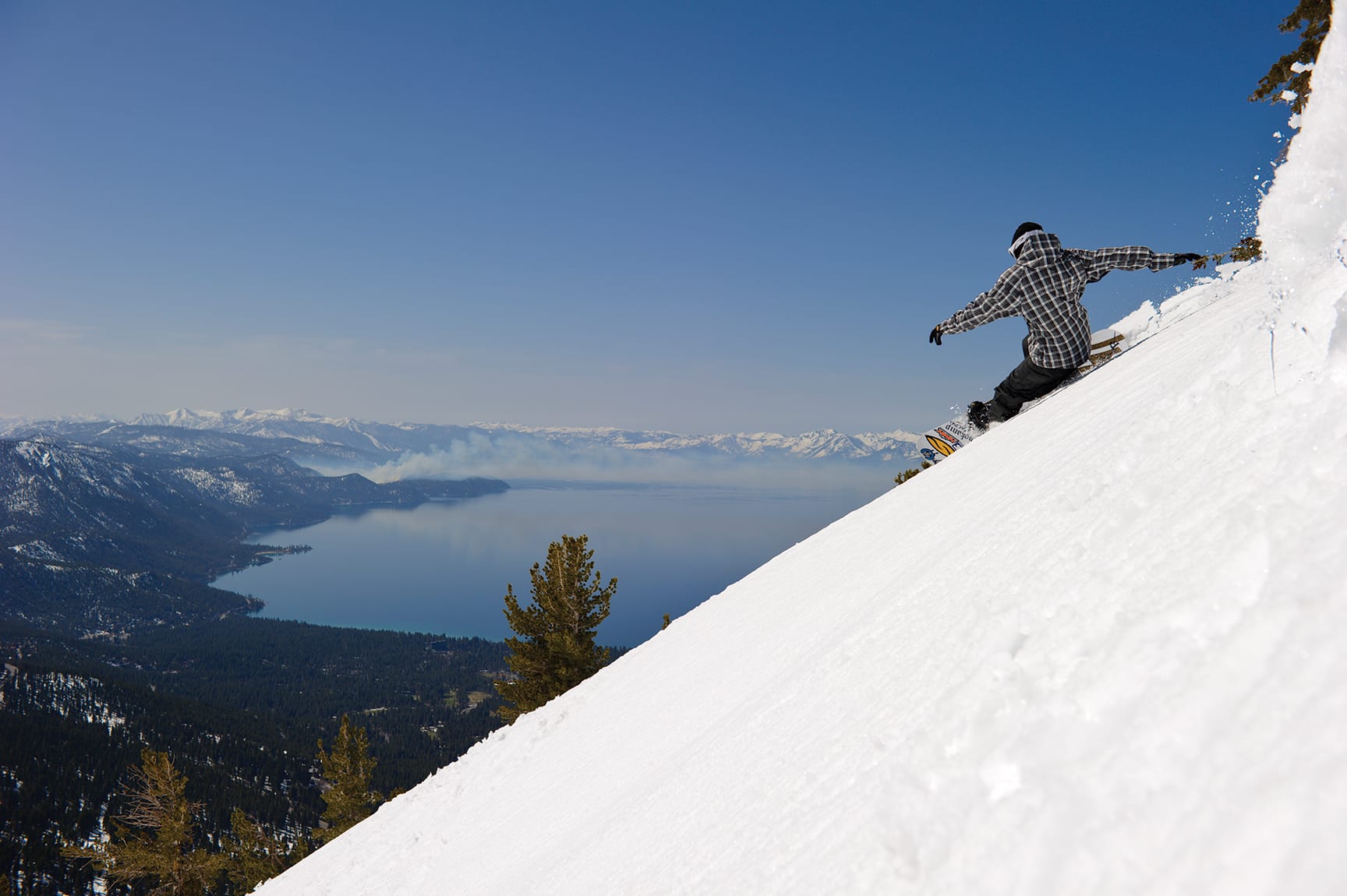
04 Oct Snowboarding’s Growing Pains
Now middle-aged, the once blossoming sport struggles to reclaim its youthful energy
In the lifecycle of a sport, snowboarding has hit its version of the midlife crisis years. The youthful exuberance and wild experimentation of the 1980s and ’90s is gone. The punk rock– and heavy metal–scored shred flicks sit like dusty, yellowed photo albums. It’s hard not to see snowboarding as a once-rebellious teenager, now turned middle-aged nine-to-fiver. The sport may be more professional and buttoned-up, but that passionate energy of the early days has waned.
The number of people snowboarding has steadily dwindled over the last decade and the number of days a snowboarder makes it to the ski hill has also declined, according to the National Ski Area Association. The sport that was once an unstoppable growth engine has sputtered.
“It really is at a crossroads,” says Bob Klein, one of the few people who has been at the frontlines of snowboarding’s evolution from virtually day one. An early North Lake Tahoe snowboarder and one-time professional snowboard agent, Klein was there when the first halfpipe runs were put down and later represented one of the sport’s biggest stars, the mercurial but immensely talented Shaun Palmer.
“I think the sport has an identity crisis. Are we gnarly core skateboarders or are we sellouts looking for the best rental package?” asks Klein.
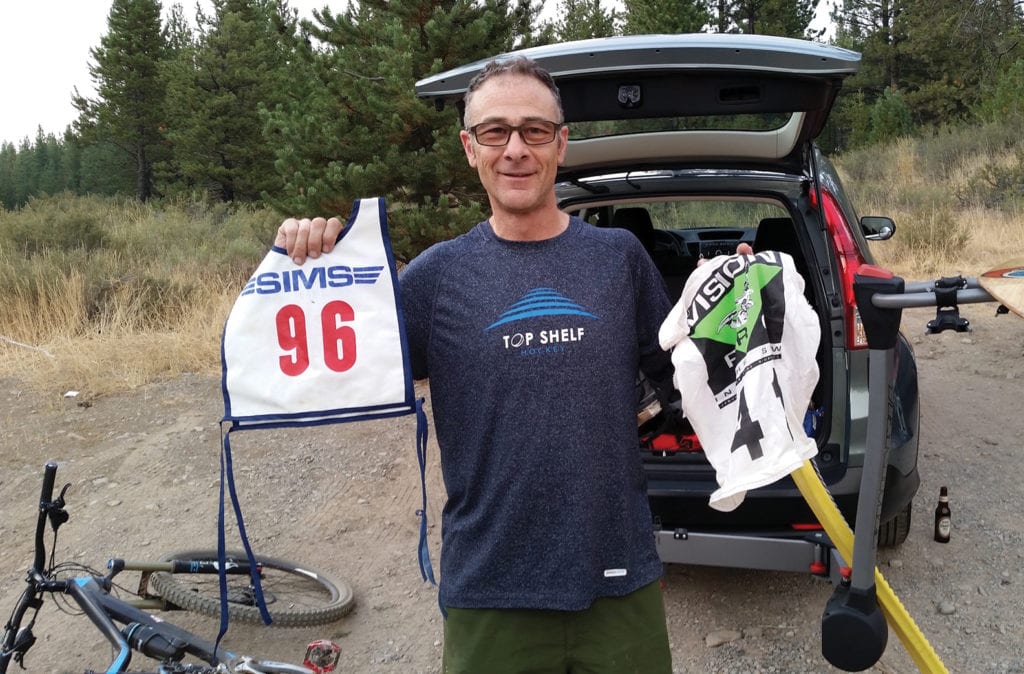 Tahoe snowboarding pioneer Bob Klein with a couple of his old racing bibs, including one from the 1984 World Snowboarding Championships at Soda Springs, photo by Sylas Wright
Tahoe snowboarding pioneer Bob Klein with a couple of his old racing bibs, including one from the 1984 World Snowboarding Championships at Soda Springs, photo by Sylas Wright
In many ways, that is snowboarding’s dilemma. The sport that started as a brash challenge to the status quo is suddenly populated by the very people it rose up against—the weekend warriors spending too much on single-day lift tickets, the once-a-year rider who treats a trip to the ski hill more like an occasional activity than a core sport.
Many of the pioneers have left or sit on the fringes. In a signal of snowboarding’s precarious position, Burton, the biggest name in the snowboarding industry, recently launched a line of camping products.
The past and present of Tahoe—a place that shaped the sport—holds clues to how snowboarding went from a magnetic and progressive sport filled with neon-clad rebels to an activity making headlines for flat-lining participation. And it might even point to how the sport will forge into the future.
From Fringe to Full Throttle
Tahoe was ground zero for many of the innovations that propelled snowboarding forward. The halfpipe originated here—a hand-dug Tahoe City dump-site ditch that would become the roots of the Shaun White–dominated freestyle wing of the sport. A crew of young Tahoe skateboarders spawned the concept while bringing skate style to the snow—names like Terry Kidwell, Damian Sanders, Palmer and others. Many of the legends of film also flourished here—pioneers like Standard Films’ Mike and Dave Hatchett, Fall Line Films’ Jerry Dugan and Arthur Krehbiel, and Mack Dawg Productions’ Mike McEntire. Meanwhile, early Tahoe snowboarders like Tom Burt and Jim Zellers helped define what was possible in big mountain terrain on a single plank.
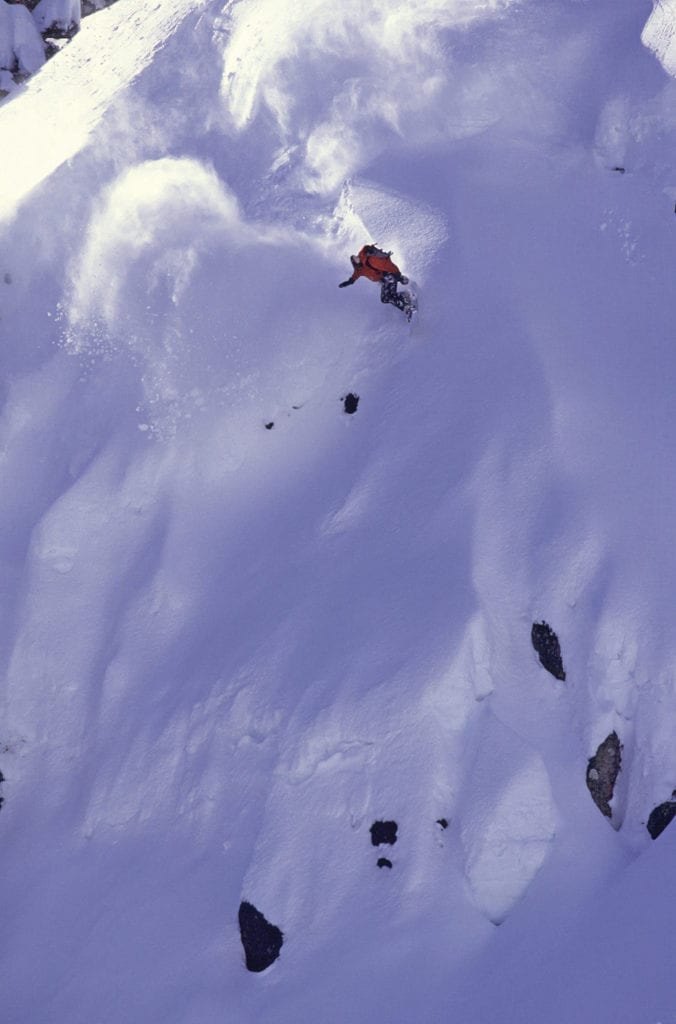
Tahoe native Tom Burt on the steeps of White Wolf between Squaw Valley and Alpine Meadows, photo by Aaron Sedway
Those were the preteen years of the sport’s tremendous growth spurts. That growth was fueled by quantum leaps in equipment innovation, riding style and terrain progression. The sport was new, brash and creative. Snowboarders were flying on top of the snow as skiers hacked through it in hops turns. Talented young riders re-imagined every terrain roll or drop as a natural feature to spin, flip or air off.
Snowboarding surged into the mainstream with all the discreetness of a heavy metal kick drum. Pearl-clutching skiers looked on in horror as snowboarders were slowly accepted at ski resorts across the country and rampaged onto groomed ski runs where they were once banned.
During those years, participation followed that blazing energy and snowboarding became a force in popular culture—beamed into living rooms across the nation and depicted on billboards as the Id of the snowsports industry.
“There was a lot of money for snowboarding back then relatively speaking,” says Burt, a Tahoe Vista native who is widely recognized as the godfather of big mountain snowboarding.
Mainstream brands embraced the raw intertia of the sport. Burt filmed for a Juicy Fruit television commercial (also featuring David Hasselhoff), and Sanders, known for his rowdy outfits and rowdier, tweaked-out backflips, was featured in a McDonalds Super Bowl commercial.
As snowboarding went from a fringe pursuit of a couple hundred misfits to a high-growth recreational activity, an industry sprang up around it. But like skateboarding or surfing before it, that tremendous wave of growth was about to wash over the sport, leaving it in between sets, looking out for the next swell of innovation to drive it forward.
Former professional snowboarder Todd Richards airs out of a throwback, hand-dug halfpipe built for the Tom Sims Retro Worlds event at Soda Springs in March 2018, photo by Sylas Wright
Maturity and Demographic Warning Signs
It’s hard to pin down when snowboarding reached maturity, but as early as 1995, some were already proclaiming its dominance.
“The revolution is over; snowboarding won. It ended bloodlessly when, earlier this month, Regis Philbin did a snowboarding bit on Live with Regis and Kathie Lee,” proclaimed Michael Farber in an article entitled Snowboard Nation in a 1995 Sports Illustrated. The tongue-in-cheek reference to the moment snowboarding vanquished skiing is even funnier in retrospect, but in the moment the insurgency was very real.
“Snowboarding is already a booming above-ground sport, and the numbers are pointed straight uphill,” Farber wrote.
But snowboarding did not handle maturity well.
By the early 2000s, the rapid growth had flagged. For the first four years of the 2000s, snowboarding’s participation rate plateaued at 2.3 million snowboarders per winter, according to data from the National Ski Area Association. There would be better years throughout the early 2000s, but the long-term trend line was tailing off into gradual decline.
The growth decline was not unusual for a relatively new sport, but it was jarring.
“It is pretty predictable to see these sports grow pretty quickly when they are young,” says David Belin of RRC Associates, which studies snowsports industry trends.
Identifying what halted snowboarding’s growth is an imprecise endeavor. Skiing certainly received a new breath of life from snowboarding, which introduced wider ski shapes and style to a sport that had grown stagnant. In this way snowboarding was a victim of its own success—its brilliant innovations were co-opted by skiing in a way that almost guaranteed skiing’s resurgence.
“Just that ability to carry speed with fat skis really changed things, and that was all influenced by snowboarding,” says Scott Gaffney, a longtime director with ski film company Matchstick Productions.
But the industry also made its own missteps. Critics say snowboarding became insular and exclusionary, catering to primarily young white male participants, and failing to broaden the activity beyond the upper middle class.
And then there was the simple inertia of a sport that was so new and growing so rapidly. At some point it had to reckon with maturity and lose some momentum.
Because of these multiple factors, the number of snowboarders began to thin. And deeper within that data are even more troubling trends. The rate of snowboarders going to the resort multiple times per year has declined substantially, according to the Snowsports Industry Association.
In the 2007–08 winter, 86 percent of snowboarders went to the hill two or more times, but that declined to 72 percent by 2016–17. Female participation has also dropped. Meanwhile, generational change is disrupting the industry as well. Millennials are less committed to snowboarding than aging Baby Boomers, who are slowly cycling out of the industry.
Klein sees this increasingly young white male core of the sport that has been the seemingly sole focus of snowboarding as an unstable demographic on which to build an industry.
“You narrow down the focus to the 14-year-old boy and that person is fickle,” says Klein.
Interestingly enough, the business side of snowsports is not struggling.
“We see some pretty healthy, pretty robust numbers when it comes to the financials,” says Belin.
Ski resort visits have been flat, but revenue is way up. While the number of snowsports participation has flatlined, the money that is made off of skiers and winter vacationers continues to climb.
Matt Peterson pays homage to snowboarding’s early years with a vintage board and neon ensemble at the 2018 Tom Sims Retro Worlds, photo by Sylas Wright
Can Snowboarding Regain its Rebel Edge?
In many ways, snowboarding has come full circle. Like a rebellious teen who bucks authority, but then eventually grows up and follows in his or her parents’ footsteps, snowboarding is now, in some ways, the mirror image of the ski industry that it defied.
“The elitism and old-boys club that they fought against, they have become that,” says Jen Gurecki, founder of Coalition Snow, a Reno-based ski and snowboard company that builds products for female skiers and riders.
The irony of the industry’s current predicament is lost on many industry insiders, adds Gurecki. “A company like Coalition Snow is looking at the industry and saying we are going to challenge the status quo, and you (snowboarders) are the status quo. And I don’t think they get that.”
Deep in the data about snowboard trends are a handful of numbers that align directly with Coalition Snow’s brash, status-quo-busting mottos like “Shred the Patriarchy.” Young girls are one of the only demographics in snowboarding that is actually growing. While all other female age groups snowboarded less often over the last several years, girls under the age of 17 picked up snowboarding at a steadily increasing pace.
“Snowboarding came to the fore because it wanted to challenge the status quo. It had its roots in the counterculture and that served snowboarding,” says Gurecki. “Where snowboarding is failing is it has not figured out to evolve with changing demographics.”
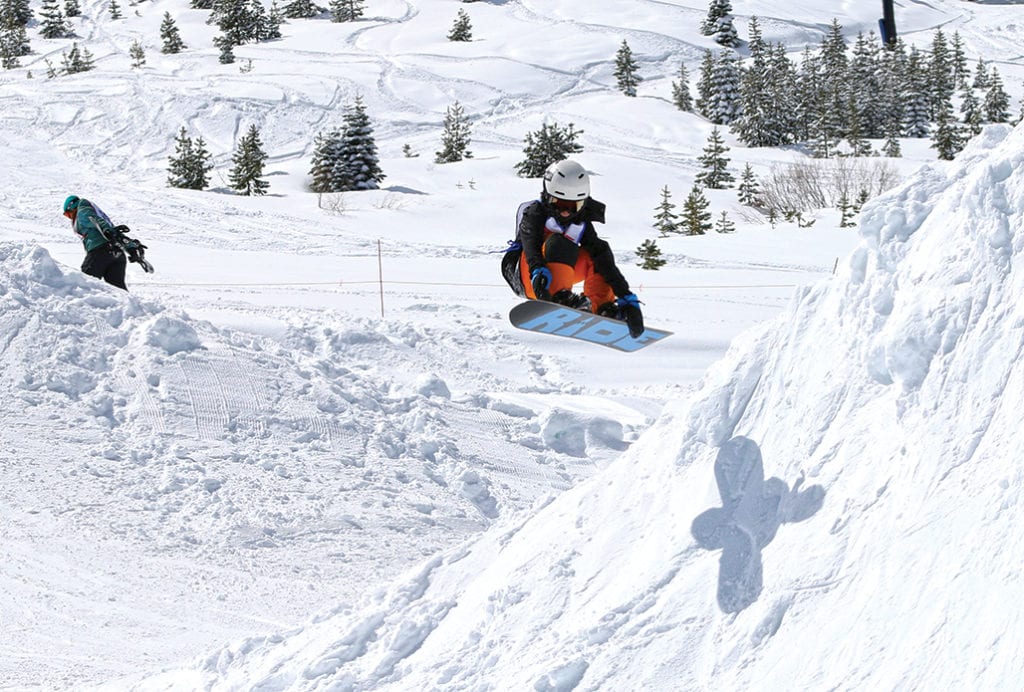 A young participant in the Tom Sims Retro Worlds, photo by Sylas Wright
A young participant in the Tom Sims Retro Worlds, photo by Sylas Wright
One bright spot, in addition to the growth in young female snowboarders, is backcountry riding. That segment of snowboarding continues to grow, and offers up a distinctly different ethos than those early years of wild excess.
Snowboarders like Burt and Jeremy Jones have pushed that part of the sport forward, embracing a mindset that is more environmentally conscious and more in tune with the long traditions of mountain culture than snowboarding’s early days.
“It seems more mellow, but snowboarding is four generations old,” says Burt.
For snowboarding to regain its youthful energy, both Burt and Gurecki agree that something has to be done to engage a wider audience.
“Ski areas, in my opinion, haven’t continued to pursue the average people to come skiing,” says Burt. “You have to buy a pass, you have to be committed, or else it is prohibitively expensive. The ski resorts on a whole have marketed to the upper middle class and upper class for skiing.”
Gurecki says that access to the sport is vital. “The reason skateboarding is all over the world is that it is cheap and anyone can do it anywhere. Snowboarding needs to get back to that vibe.”
Of course, just like skiing used snowboarding technology and riding styles to harness its own revival years ago, snowboarding could develop new equipment and new ideas to draw in more participants. Burt says the most likely new innovation would be a revolution in the boot and binding combination that would make the sport easier.
“Snowboarding will have a revival in the next generation. It is all a cycle,” says Burt.
In the most elemental sense, snowboarding grew because it was simply fun to do. That might be the element that sparks a new generation to take it to the next level.
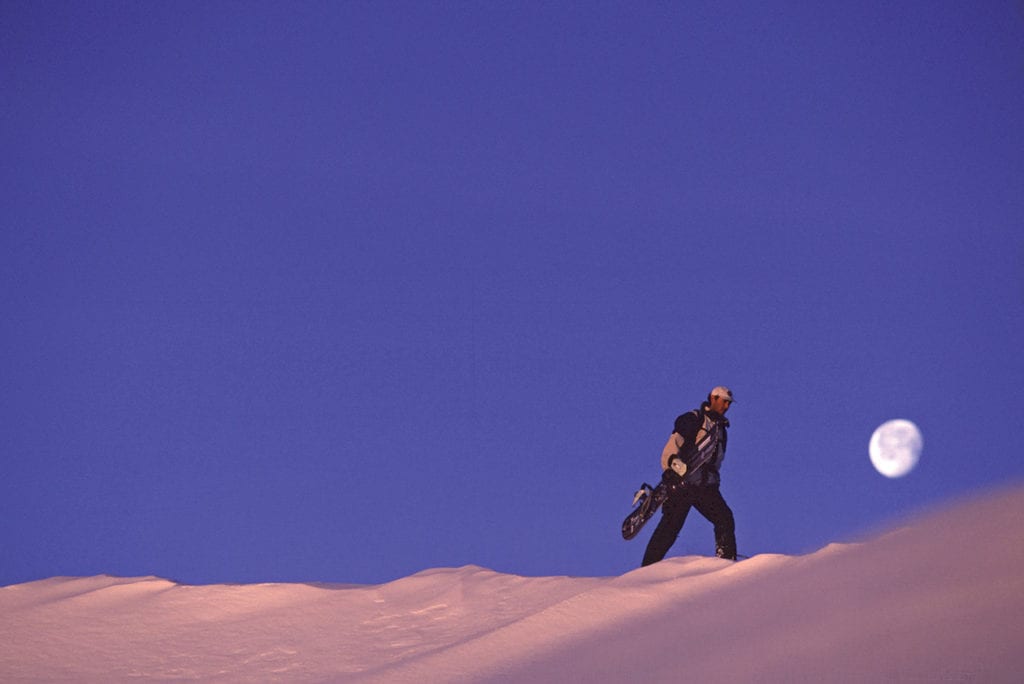 Tom Burt of Tahoe Vista is among snowboarding’s most respected pioneers, photo by Aaron Sedway
Tom Burt of Tahoe Vista is among snowboarding’s most respected pioneers, photo by Aaron Sedway
When Burt received the Legend Award from Transworld Snowboarding in 2010, he thanked a long list of pioneers in the sport “for pursuing this stupid useless sport that has no sense, except for fun.”
In an interview after the award, he was asked why decades after becoming a snowboarder he still rides, guides and pursues snowboarding with a passion.
“There’s no reason to stop,” he said. “I still love to make powder turns. It is still fun. It still puts a smile on my face. And these days I also have my kids, and when they are smiling when they are playing in the snow, it puts an even bigger smile on my face.”
David Bunker is a Truckee-based writer, editor and snowboarder. He plans to ride into his creaky old age for the pure love of the sport. Tahoe Quarterly editor Sylas Wright contributed to this article.




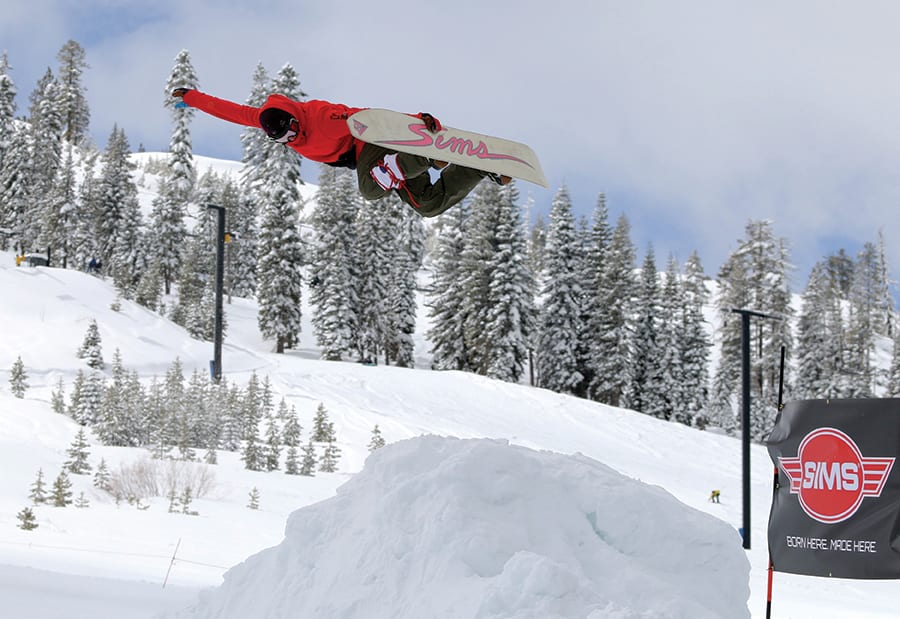
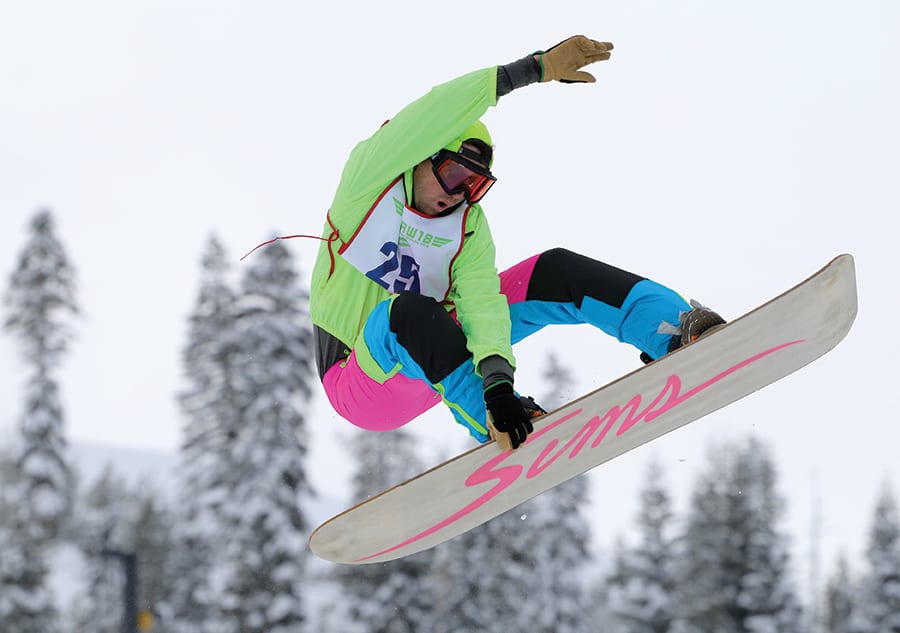
Earl Zeller
Posted at 16:12h, 06 OctoberIf kids nowadays want to sit on the couch and play video games, thats just more pow for me.
If you would like to see how it was done “back in the day”, (just like a Hollywood 80’s movie remake), come join us at the Tom Sims Retro Worlds held every last weekend in March at Soda Springs resort.
Earl Zeller
http://www.winterstick.net/nav/tales_ez1.html